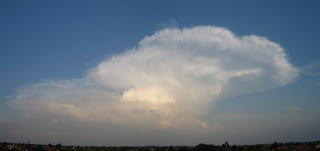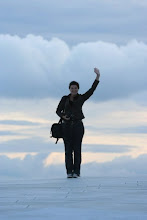Corona around the sun. The effect of the droplet sizes on the corona can be seen here.
Wednesday, 30 May 2007
Korona - Corona
Korona a nap körül. A korona kinézete a vízcseppek méretétől függ.
Corona around the sun. The effect of the droplet sizes on the corona can be seen here.
Corona around the sun. The effect of the droplet sizes on the corona can be seen here.
Tuesday, 29 May 2007
Antikrepuszkuláris sugarak és szivárvány küllők - Anti-Crepuscular Rays and Rainbow Spokes
A képeken antikrepuszkuláris sugarak látszanak, amint a nappal ellentétes (antiszoláris) pont felé haladnak. Röviddel ezután szivárvány is feltűnt az égen, melyen így megjelentek a küllők. Panoráma képek eredeti méretben itt és itt.
Anticrepuscular rays are visible in these pictures converging in the antisolar point. Shortly after this sight, a rainbow appeared, thus creating rainbow spokes. Panorama photos in original size here and here.
Monday, 28 May 2007
Számfeletti ívek / Supernumeraries
*
A fotó tegnap készült Szajlán. Nagyon halványan látszik a másodlagos ív is (balra a villanyoszlop fölött), illetve picit a fő szivárvány alatti számfeletti ívek. Csatoltam a képek módosított változatát is, ahol állítottam a színtelítettségen, hogy jobban ki lehessen venni az extra íveket.The picture was taken yesterday in Szajla, Hungary. There's a very faint secondary rainbow (above the electric pylon on the left). The supernumeraries below the primary bow are also visible a little. I've added the modified versions of the photos with the saturation set to make the secondary and supernumerary bows more visible.
Saturday, 26 May 2007
Középkori légköroptika - 7.
Fogadó cégére Mortimer's Cross-nál, rajta a három nap. Forrás
Sign of an inn at Mortimer's Cross, with the three suns. Source
Sign of an inn at Mortimer's Cross, with the three suns. Source
Egyik hozzászólásomban pár hónapja ugyan leírtam már, de hadd álljon itt a fő oldalon is. 1461 február 2-án az angliai Mortimer's Cross-nál (Herefordshire) az akkor 18 éves Edward, March grófja (a későbbi IV. Edward) megütközött Owen Tudorral és fiával. Edward Yorkot, Owen Tudor pedig a Lancaster házat képviselte a Rózsák Háborújában. A csata előtt két melléknap tűnt fel az égen, melyet csodálatos jelnek tartottak, és miután Edward győzedelmeskedett, már nem csak a fehér rózsa, hanem a nap is a York ház egyik szimbóluma lett. Shakespeare a következőképp írta le a híres jelenséget VI. Henrik 3. részében (2. felvonás, 1. szín).
EDVÁRD.
Szemem káprázik? Három nap van ott!
RIKHÁRD.
Három sugárzó teljes nap, igen!
El nem borítják felhők járati,
Elválva tisztán halvány derüs égtől.
Nézd, nézd! csókolva egymást ölelik,
Mikéntha szent frigy esküjét fogadnák.
Most mind a három egy láng, egy nap, egy fény!
Nagy eseményt jósolnak az egek.
EDVÁRD.
Még soh’se hallott ritka csoda ez.
Ugy gondolom, a harczba hí, öcsém!
Hogy mi, a hős Plantagenet fiai,
Külön ragyogással fénylve mindegyik,
Most súgarunkat mégis egyesítsük
S a földre szórjuk, mint az a világra.
Bármit jelent, ezentúl pajzsomon
Három napistent hordok czímerűl.
On 2 February 1461, the 18-year-old Edward, earl of March (who became Edward IV later) fought a decisive battle against Owen Tudor and his son at Mortimer's Cross, Herefordshire. The battle was part of the War of Roses and the Yorkist Edward defeated the Lancastrians. Before the fight, two parhelia had appeared in the sky, a marvellous sign for the two armies. To remember this event and commemorate the victory, the sun - besides the white rose - became York's symbol. In Shakespeare's Henry VI, part 3 (act 2. scene 1.) we can read a poetic description of the phenomenon.
EDWARD
Dazzle mine eyes, or do I see three suns?
RICHARD
Three glorious suns, each one a perfect sun;
Not separated with the racking clouds,
But sever'd in a pale clear-shining sky.
See, see! they join, embrace, and seem to kiss,
As if they vow'd some league inviolable:
Now are they but one lamp, one light, one sun.
In this the heaven figures some event.
EDWARD
'Tis wondrous strange, the like yet never heard of.
I think it cites us, brother, to the field,
That we, the sons of brave Plantagenet,
Each one already blazing by our meeds,
Should notwithstanding join our lights together
And over-shine the earth as this the world.
Whate'er it bodes, henceforward will I bear
Upon my target three fair-shining suns.
Thursday, 24 May 2007
Cornucopia
Monday, 21 May 2007
Bishop's ring and blue moon - Bishop-gyűrű és kék hold




Ma nagy meglepetésként egészen különös fény volt az égen. Sokáig néztem, mi lehet és a párára gyanakodtam, aztán hála Nolinak, sikerült beazonosítani azzal, amit eddig csak képeken láttam. Szóval ez a Bishop-gyűrű, egy rendkívül ritka jelenség, amit először Sereno Bishop írt le a Krakatau 1883-as kitörése után. A létrejöttéhez finom és egyenlő nagyságú porszemcsék (kb. 0.001 mm) kellenek jó magasan a légkörben. Ezúttal ezt nem vulkán szolgáltatta, hanem szaharai homok. A jelenség Európában - ha nem tévedek - utoljára 1991-ben volt megfigyelhető a Pinatubo kitörése után. A Bishop-gyűrű sugara 28 fok, és jellemzően belül kékesfehér, kívül sárgásbarna, esetleg lilás, a gyűrű által határolt terület pedig lényegesen világosabb, mint azon kívül. A fotó sajnos csak kis mértékben adja vissza a színeket. Jó lenne holnap jobb képeket készíteni róla. Az első két képet CanonA85-tel készítettem, a második két képet András csinálta Olympus C-740UZ géppel.
Today there was some really strange light in the sky. For a while I thought it was caused by the mist, but then, thanks to Noli, I could identify it with the phenomenon that I had seen only in pictures so far. So this is Bishop's ring, an extremely rare sight, which was first described by Sereno Bishop in 1883 after the eruption of the volcano Krakatoa. Microscopic (c. 0.001 mm) dust particles of about the same size are needed for this phenomenon. This time Saharan sand in the high atmosphere caused its appearance. If my information is correct, last time it was seen in Europe was after the 1991 eruption of Pinatubo. The radius of the ring is about 28 degrees, the sun characteristically has a bluish-white aureole, surrounded with yellow-brownish or purple. Also, the area within the ring is much brighter than the sky is otherwise. The colours of the photos could be better ... it'd be nice to take some more tomorrow. The first two pictures were taken by my CanonA85, the other two are from András (Olympus C-740UZ).


És emiatt ma még a hold is kék...
And for this reason, tonight the moon is blue...
Earth Science Picture of the Day
Spaceweather.com :)


Itt látszik a NASA aerosol (mikroszkópikus por/füst részecskék a levegőben) térképein a porfelhő Magyarország felett május 20-án és 21-én.
NASA's aerosol (microscopic dust/smoke in the air) maps show the amount of dust in the high atmosphere above Hungary on the 20th and 21st of May.
Sunday, 20 May 2007
Jeli Arborétum - május 19.
Thursday, 17 May 2007
Egy béna telefonos kép
Tuesday, 15 May 2007
Kettős szivárvány





A ma délutáni vihar után este gyönyörű kettős szivárvány volt az égen, és egy hasonlóan gyönyörű naplemente. A képek András barátomat dícsérik, aki továbbra is nagy lelkesen helyettesíti elromlott fényképezőgépem. Lassan ő is indíthat egy légköroptikás blogot, kezdem megfertőzni! Igaz, András?
After today's storm, there was a magnificent double rainbow in the sky, together with a similarly fantastic sunset. I owe thanks to my friend, András, who happily substitutes my camera with his own one, until mine is repaired. Soon he'll start making an atmosheric optics blog, too ;) - he's getting infected.
Sunday, 13 May 2007
Pilis - 2007. május 12.
The fragment of a halo and a faint sundog yesterday afternoon near Pilis, Hungary.
Wednesday, 9 May 2007
Melléknap(ocska) - 2007- május 8.



Alig látható melléknap tegnapról, a nagy fától jobbra. Meg egy kis oppozíciós effektus (ellenfénynek). Ma volt 22-es, melléknapok két oldalt és zenitkörüli, de mivel most nincs saját fényképezőgépem, lemaradtam róla.
A little sundog from yesterday (quite difficult to spot: to the right of the big tree), and opposition effect. Today there were parhelia, halo and a circumzenithal arc in the morning, but not having my own camera, I couldn't take a photo of them.
Sunday, 6 May 2007
Subscribe to:
Comments (Atom)










































